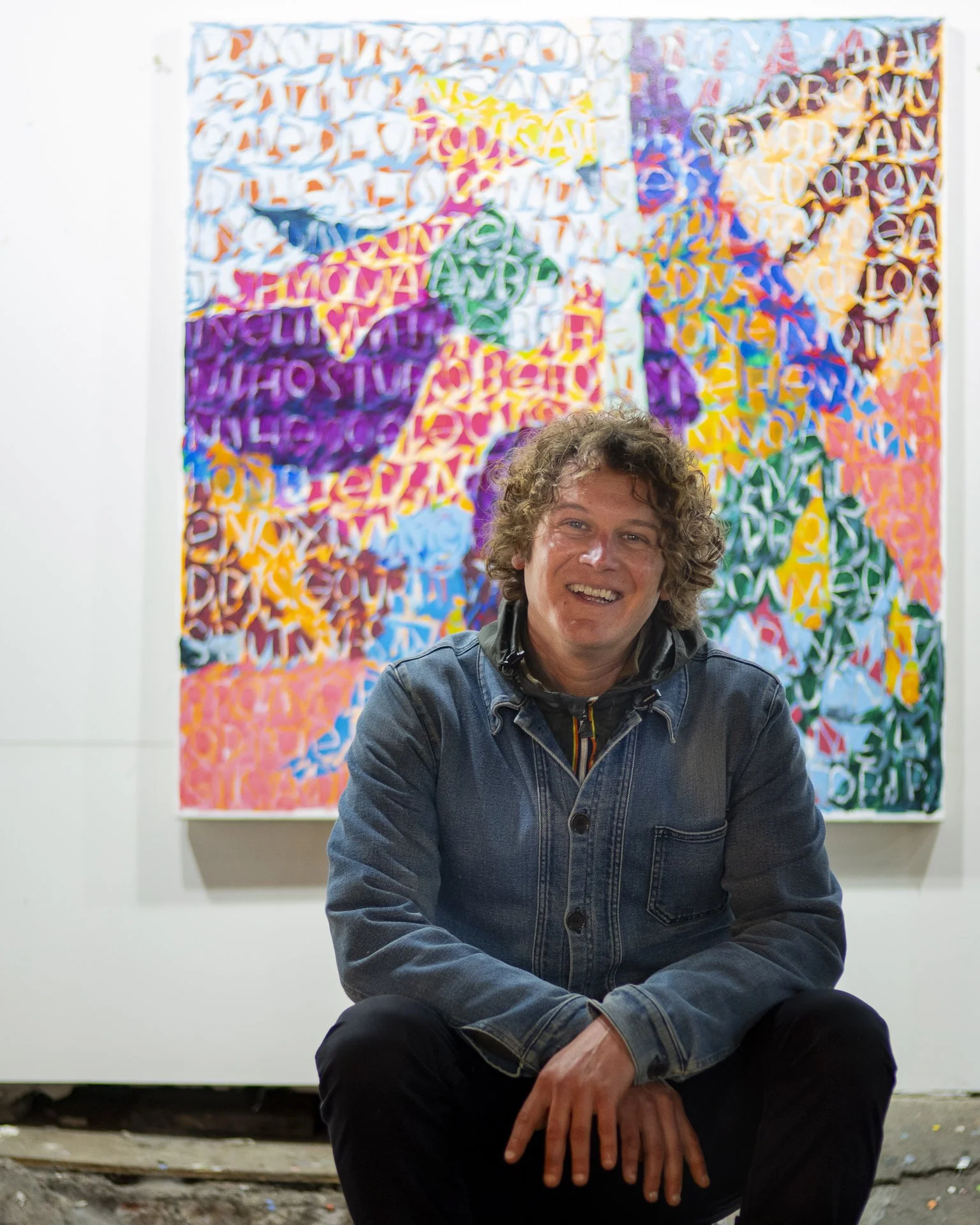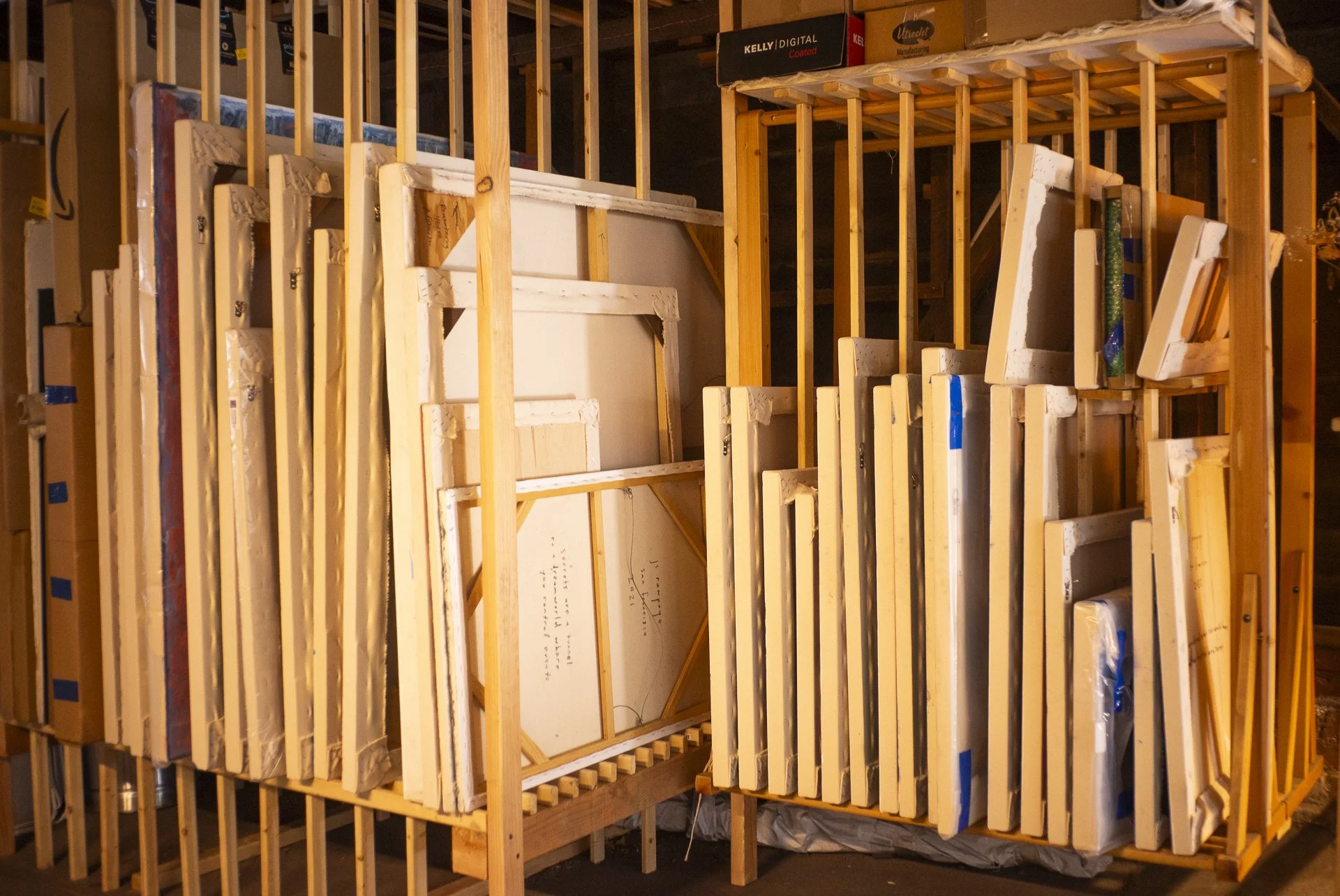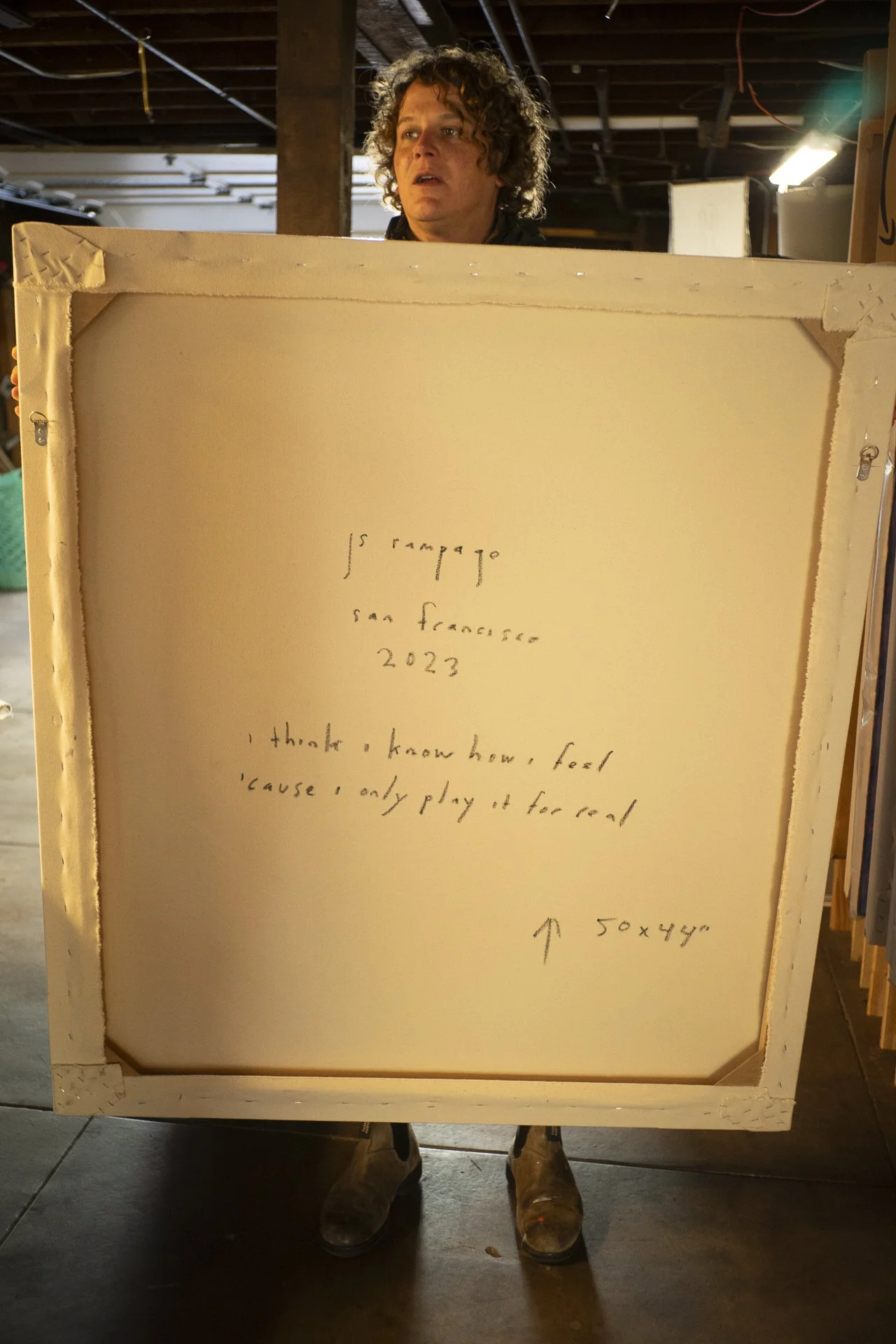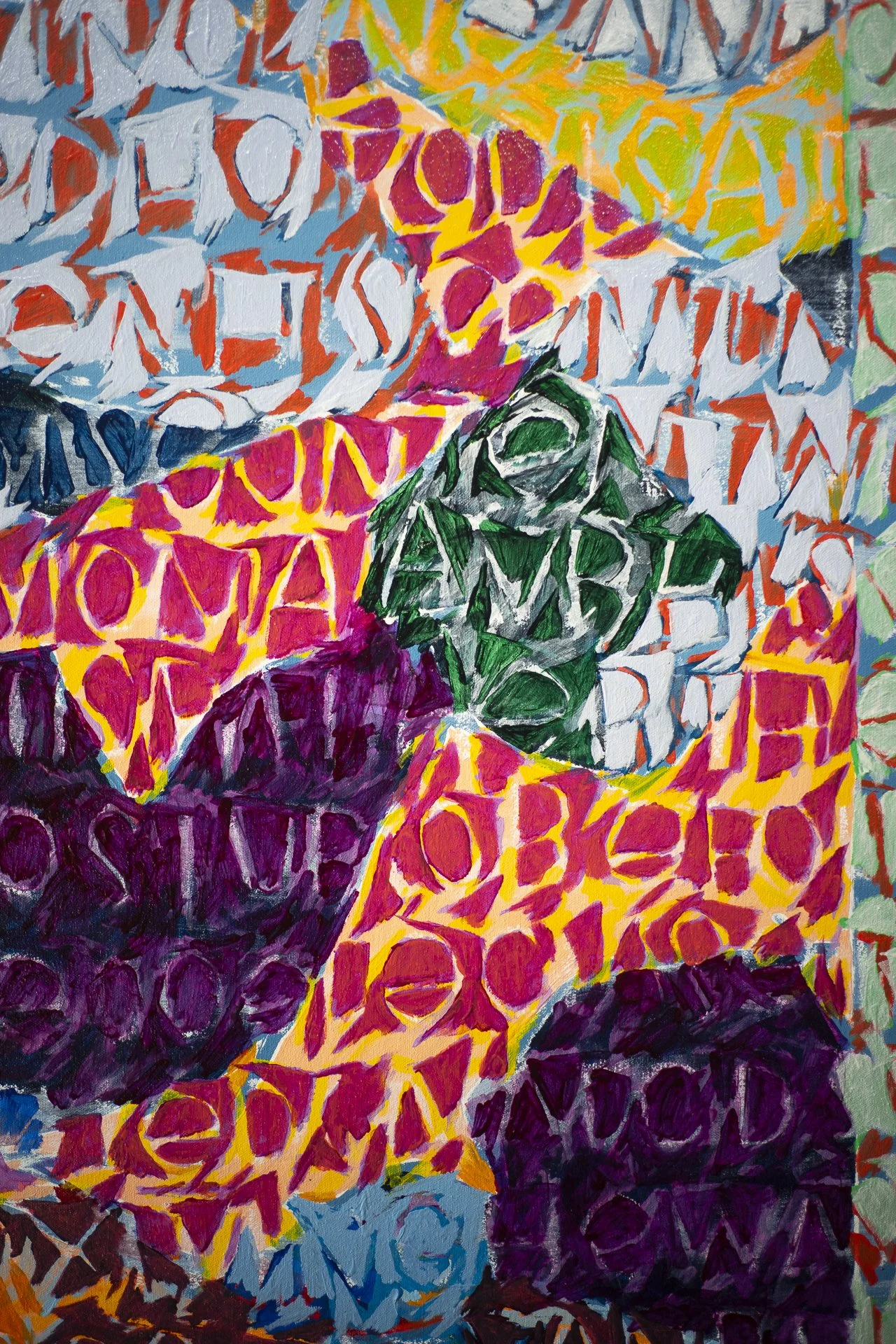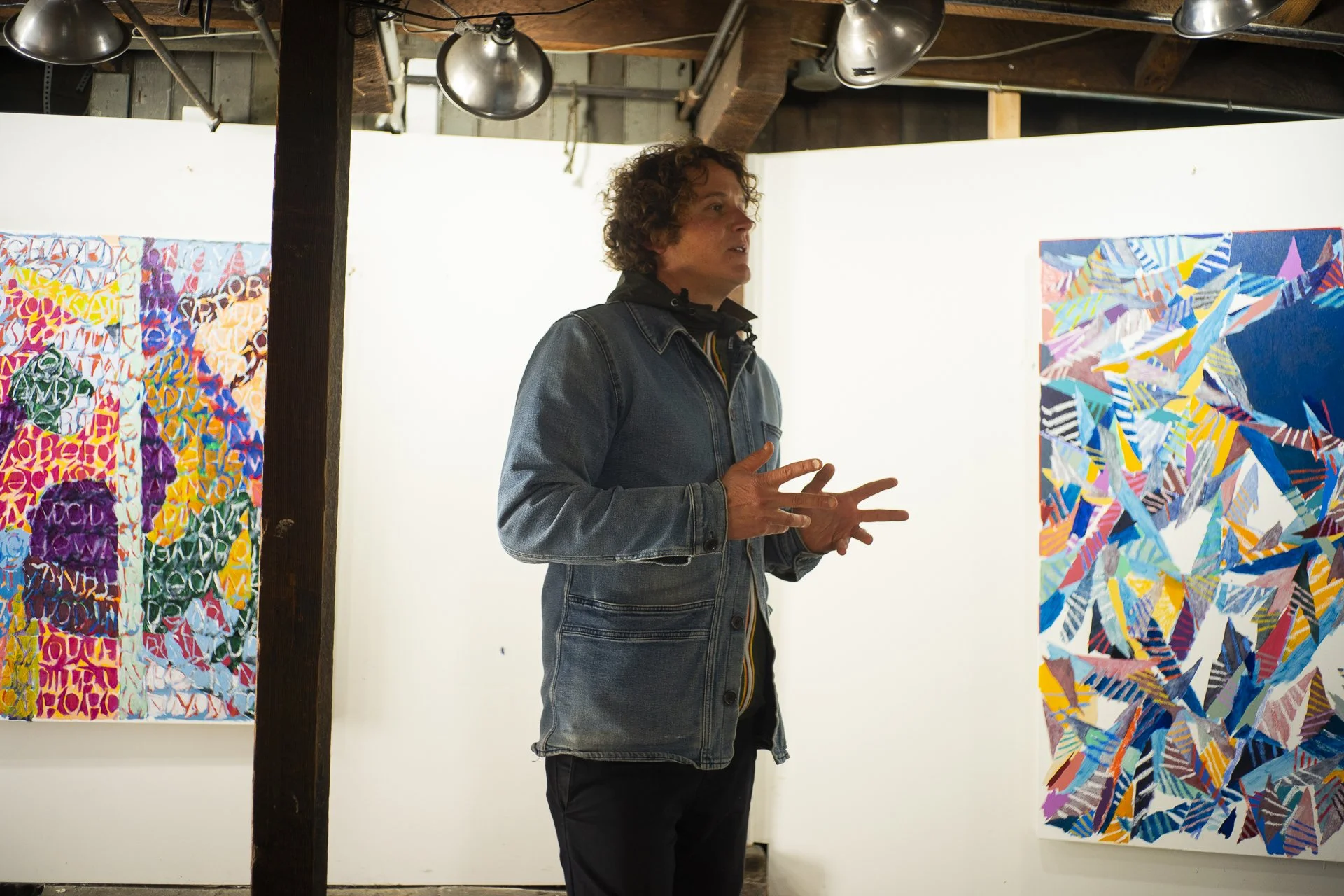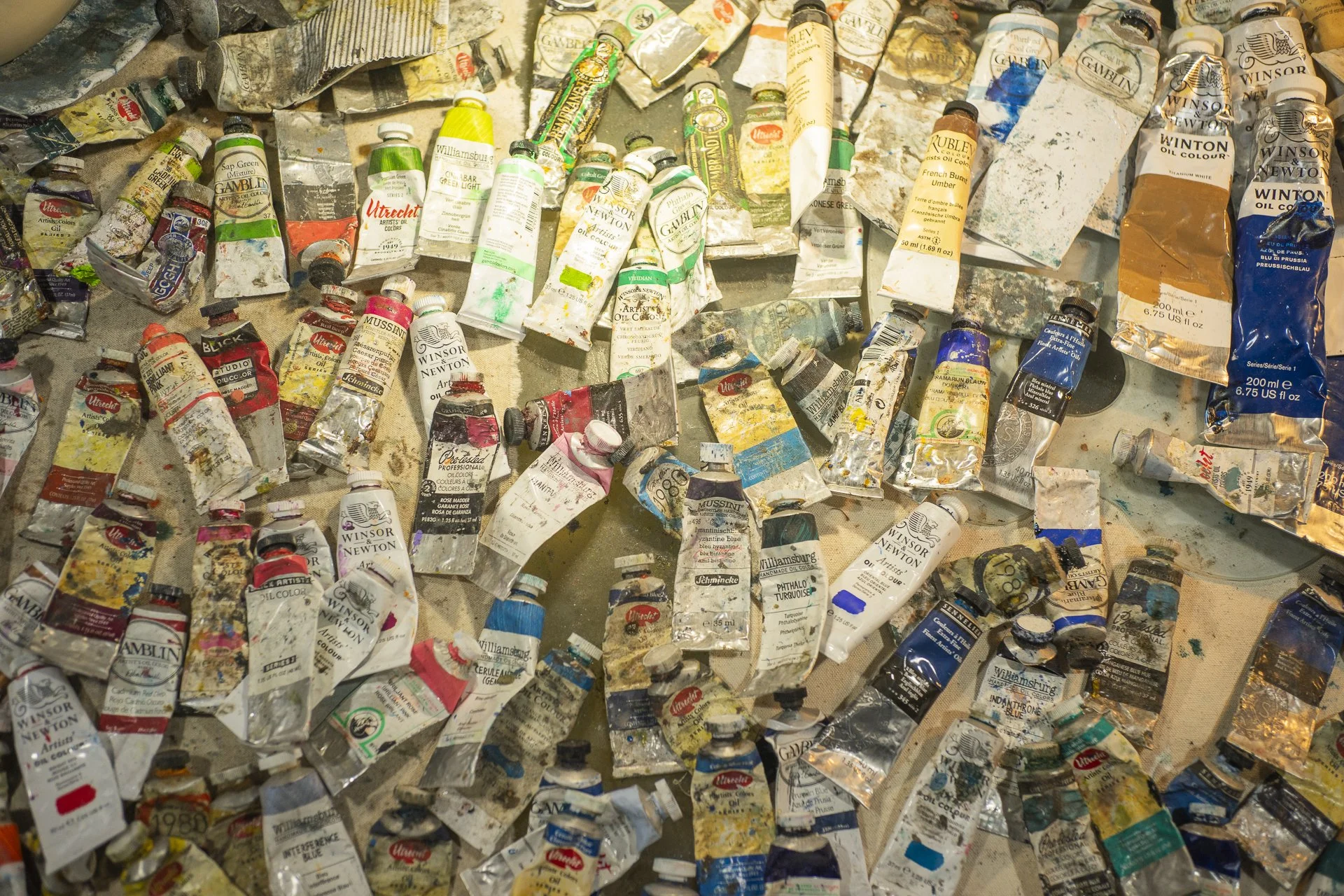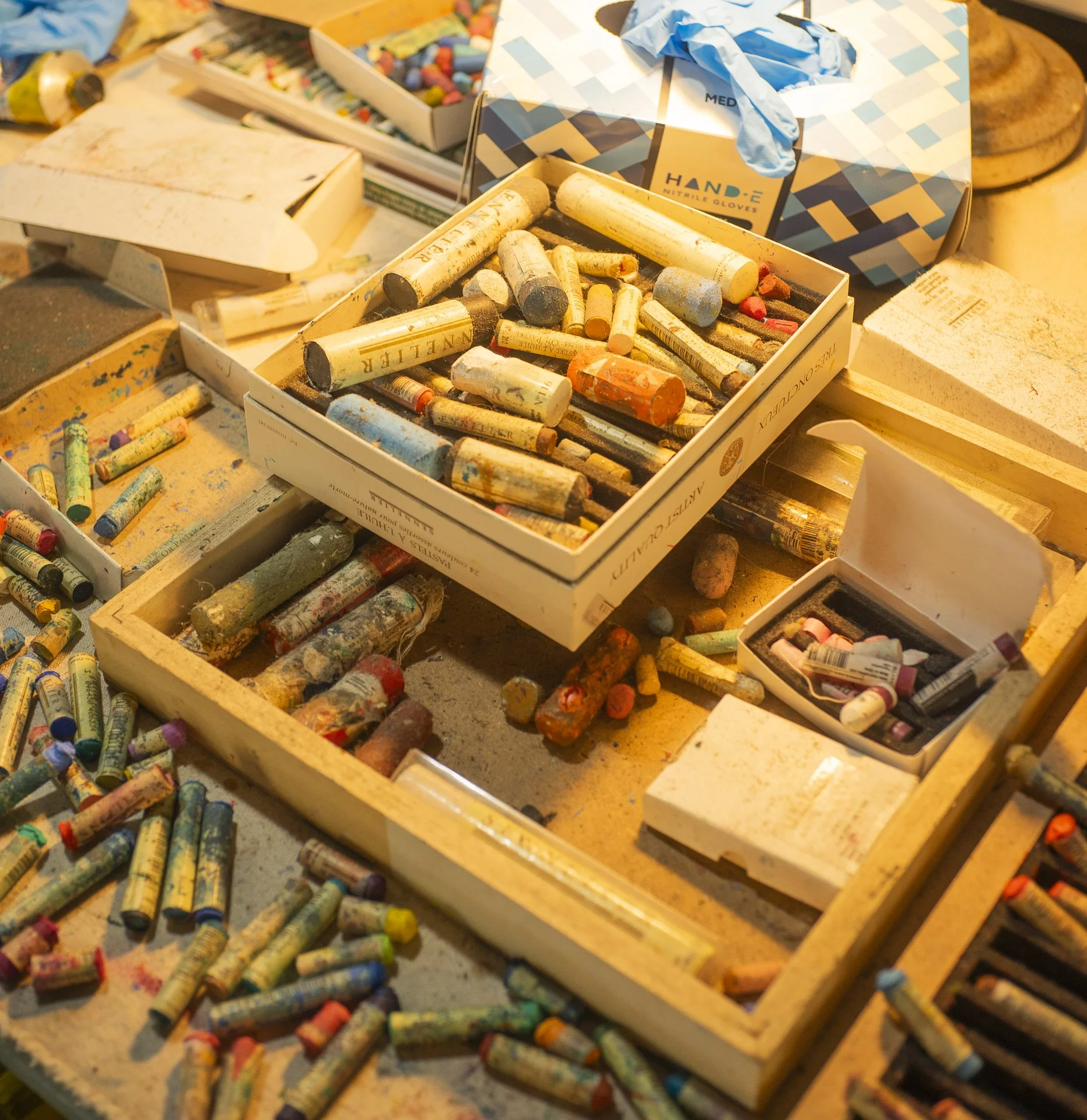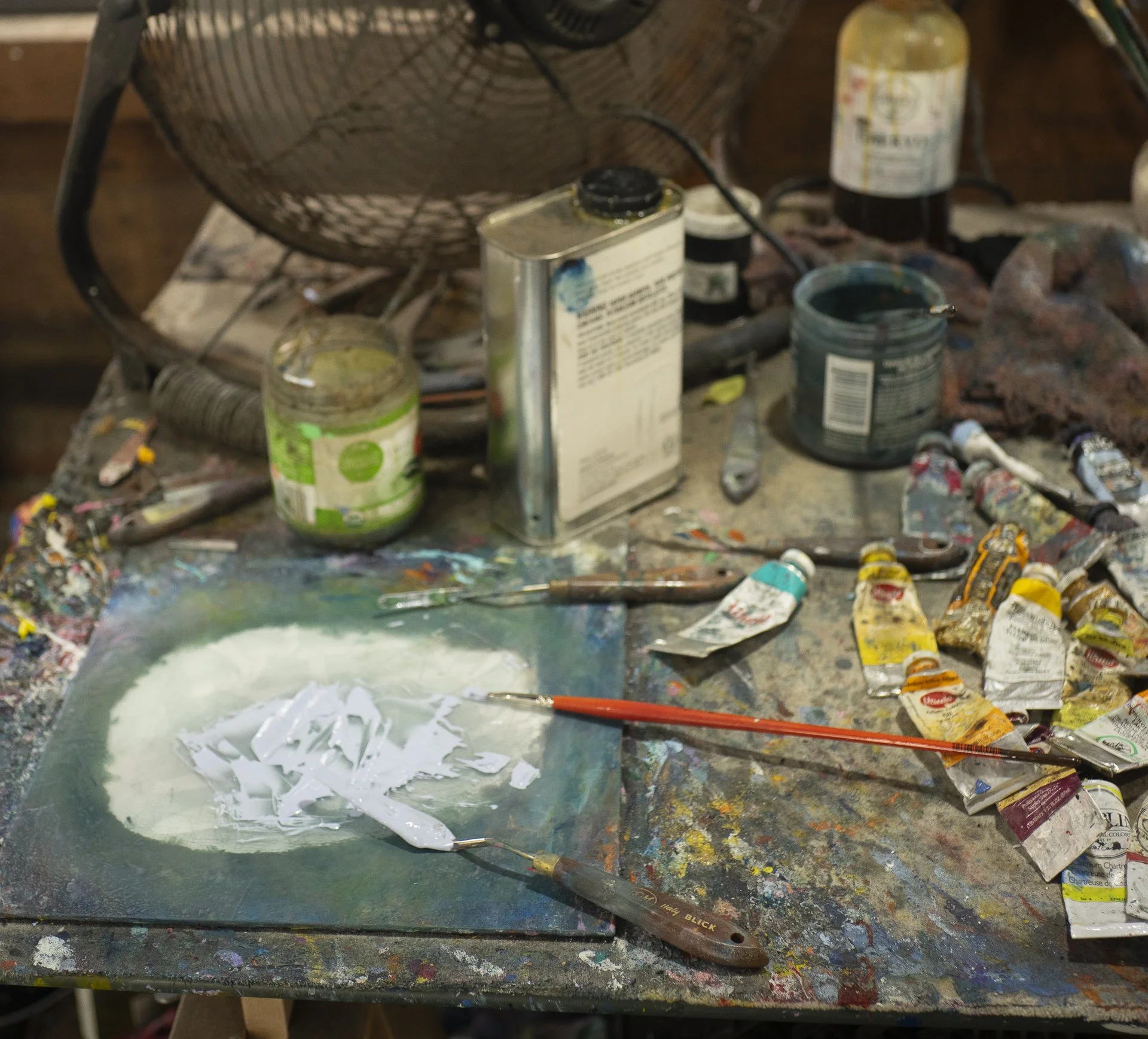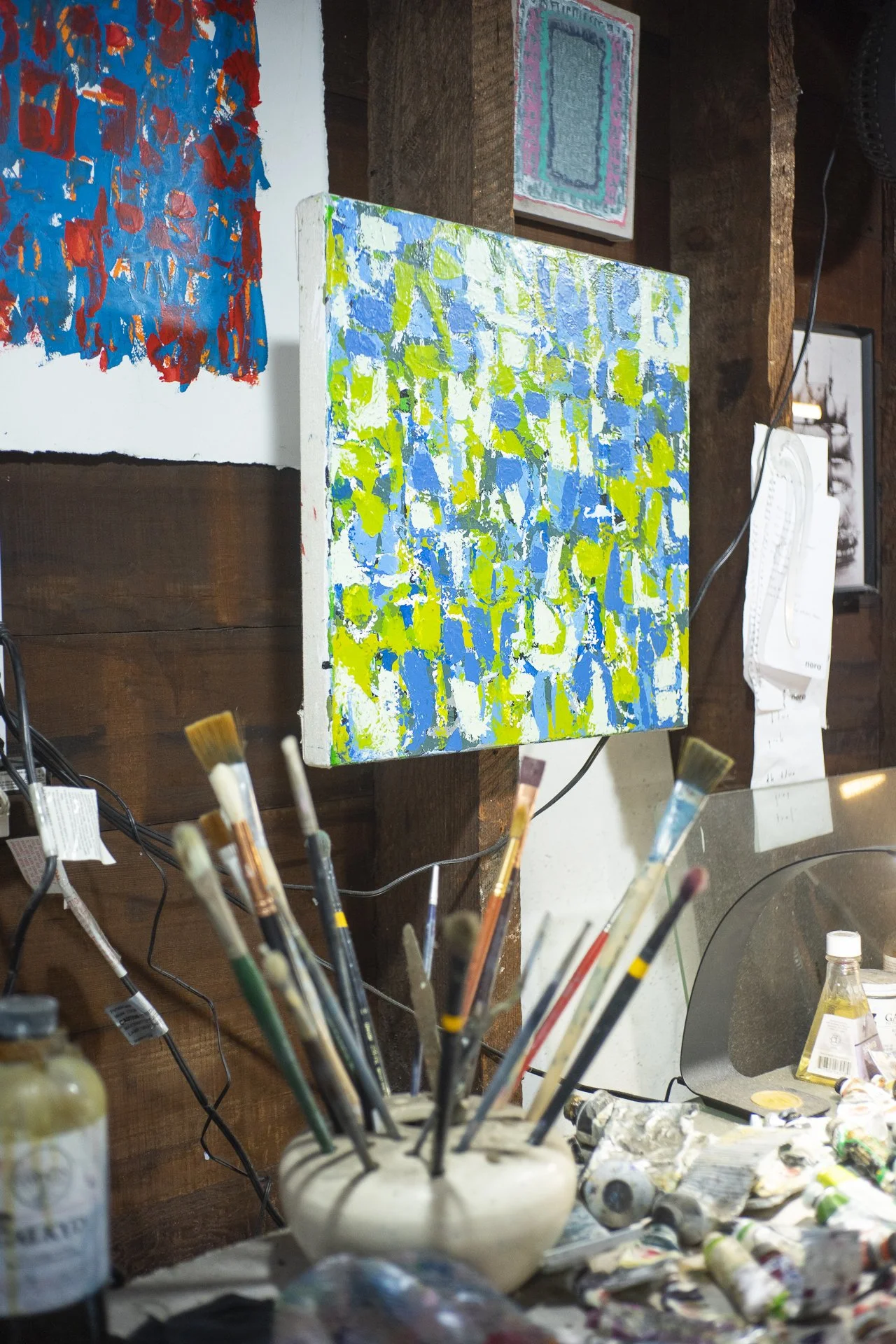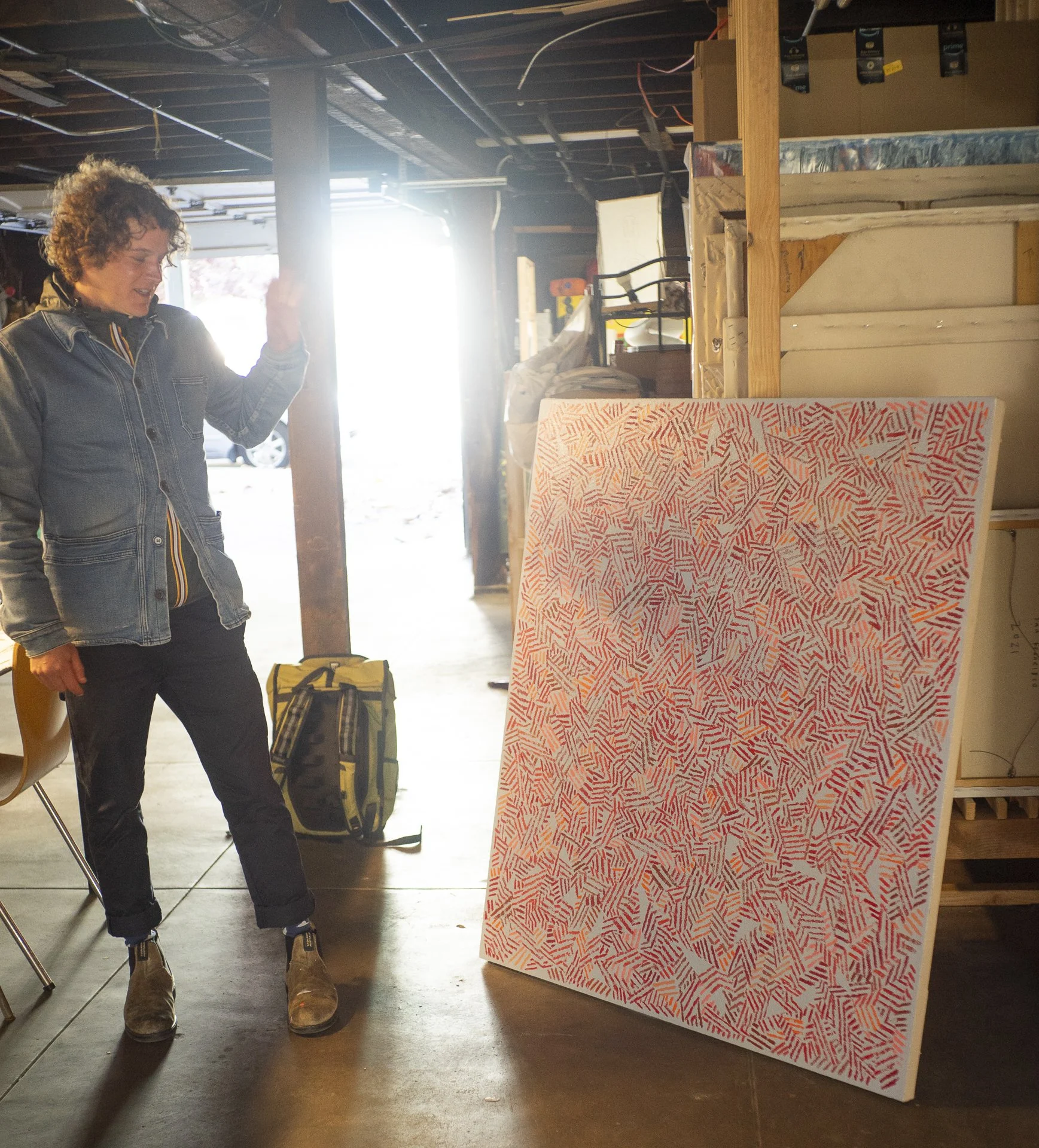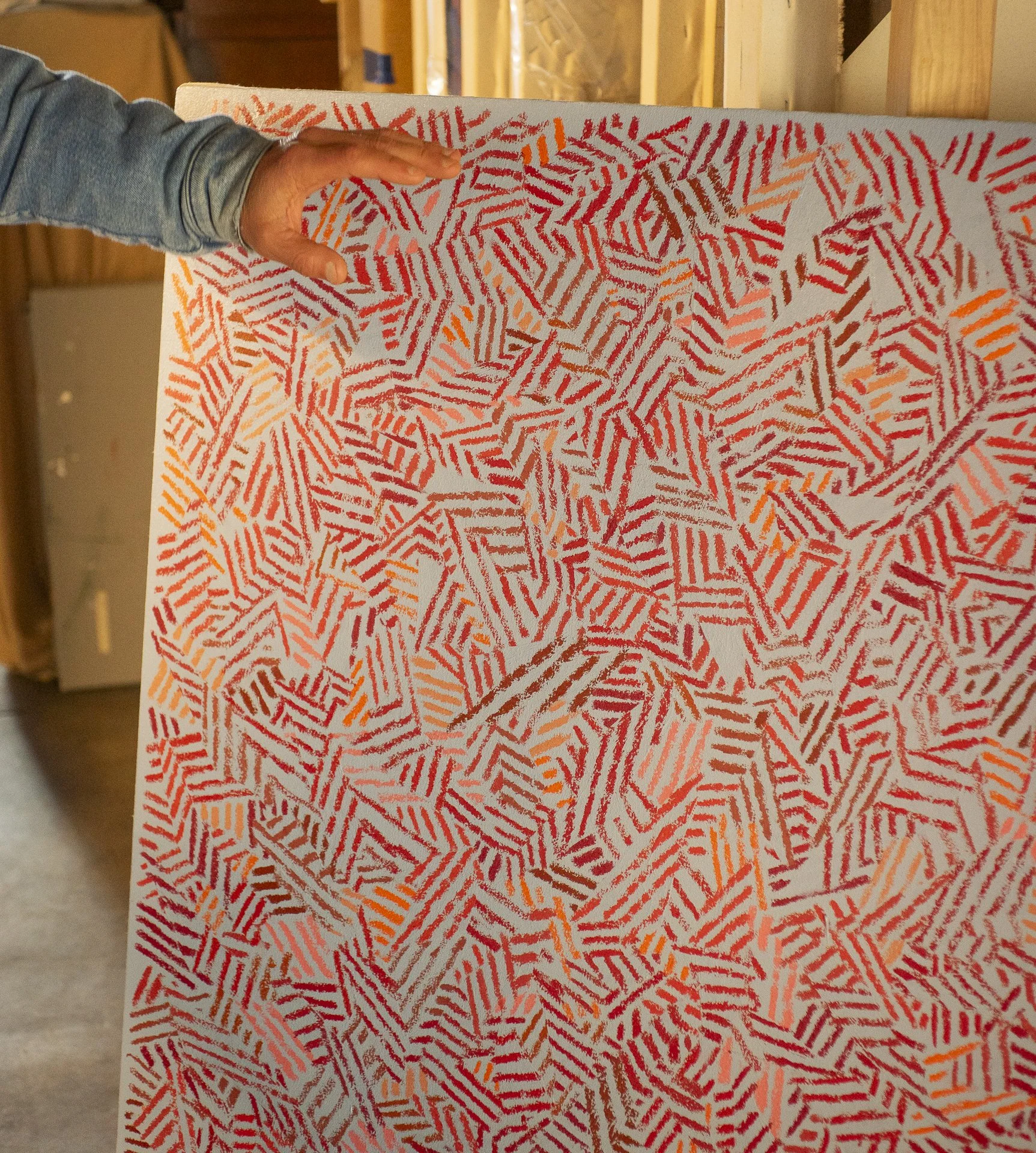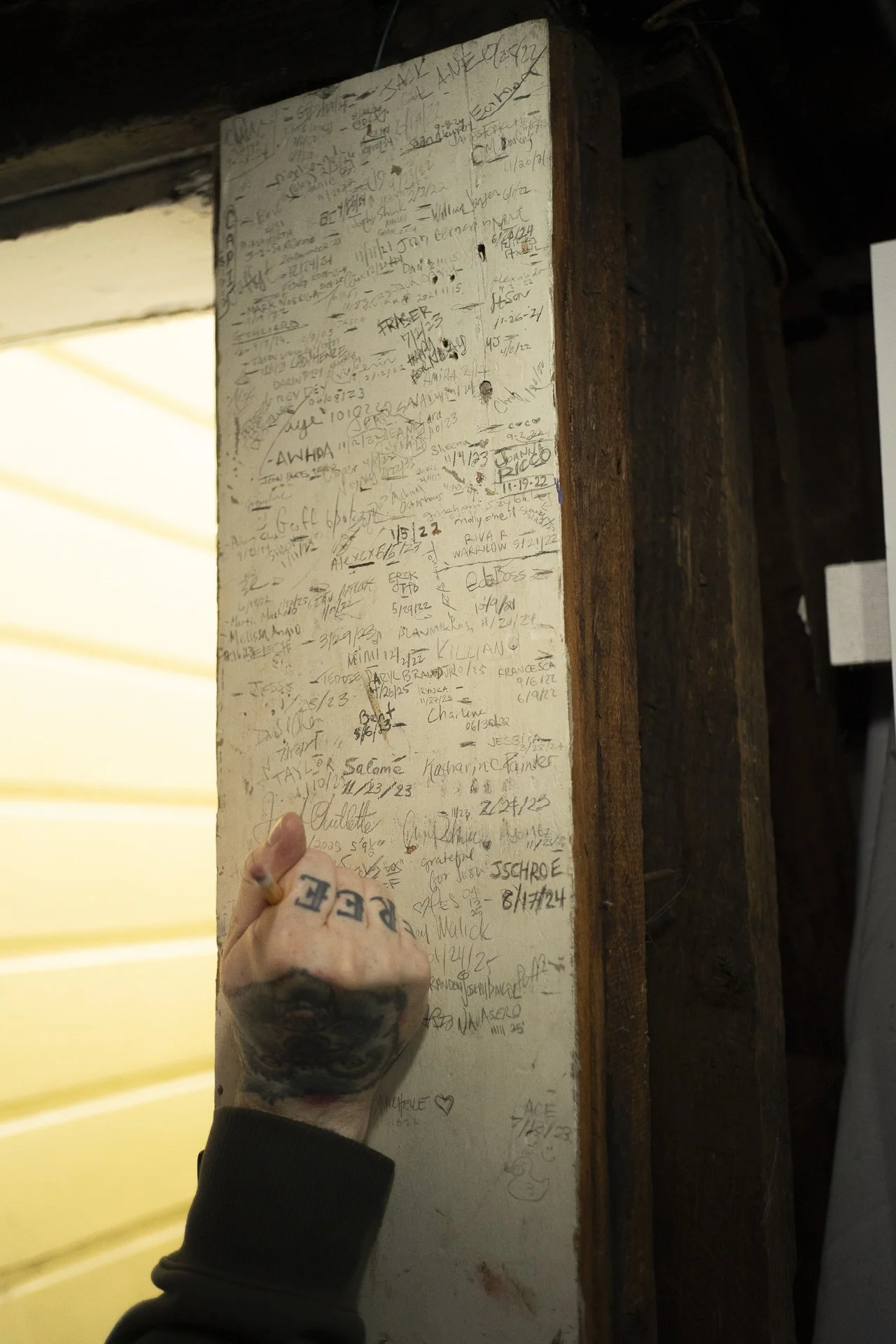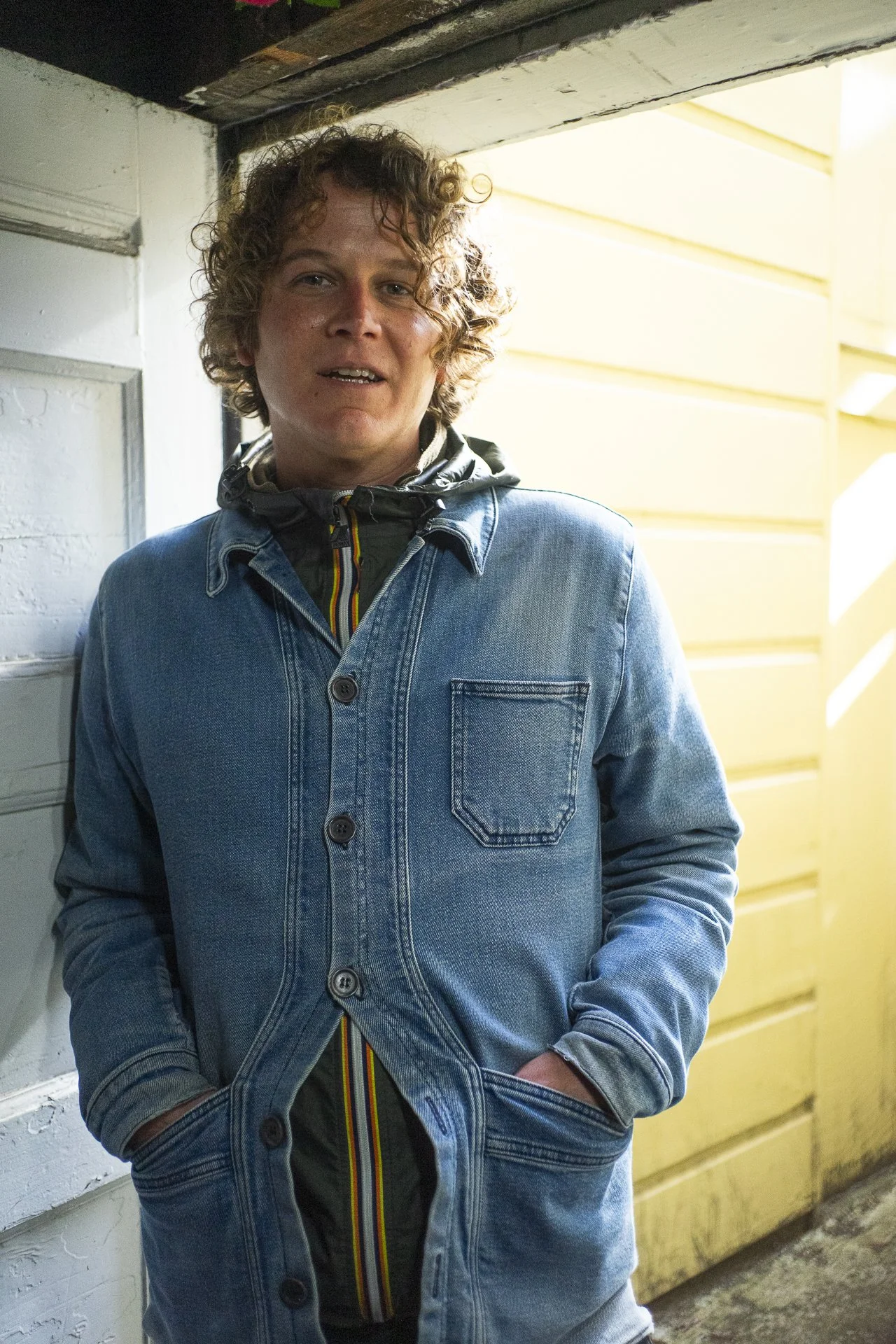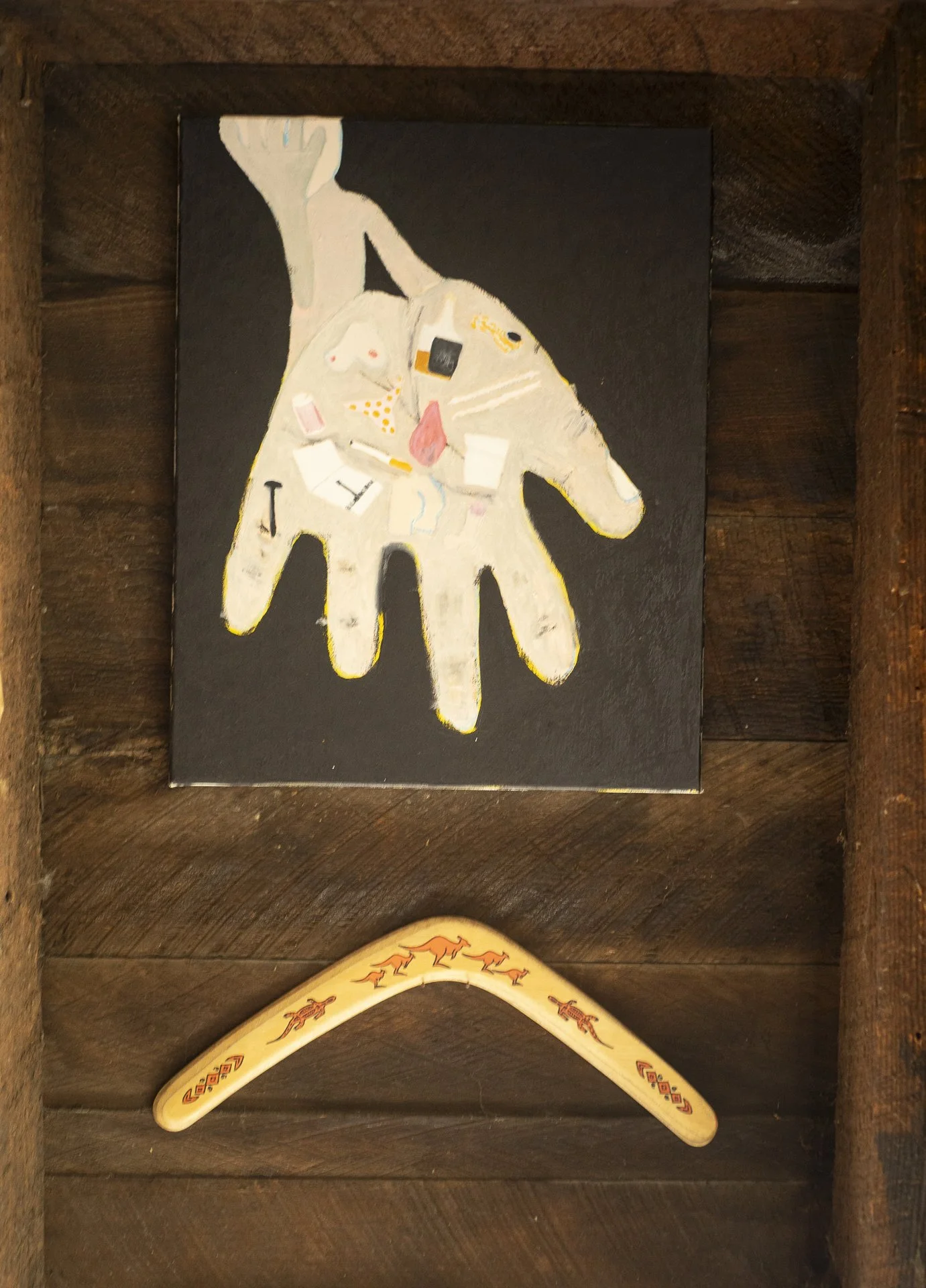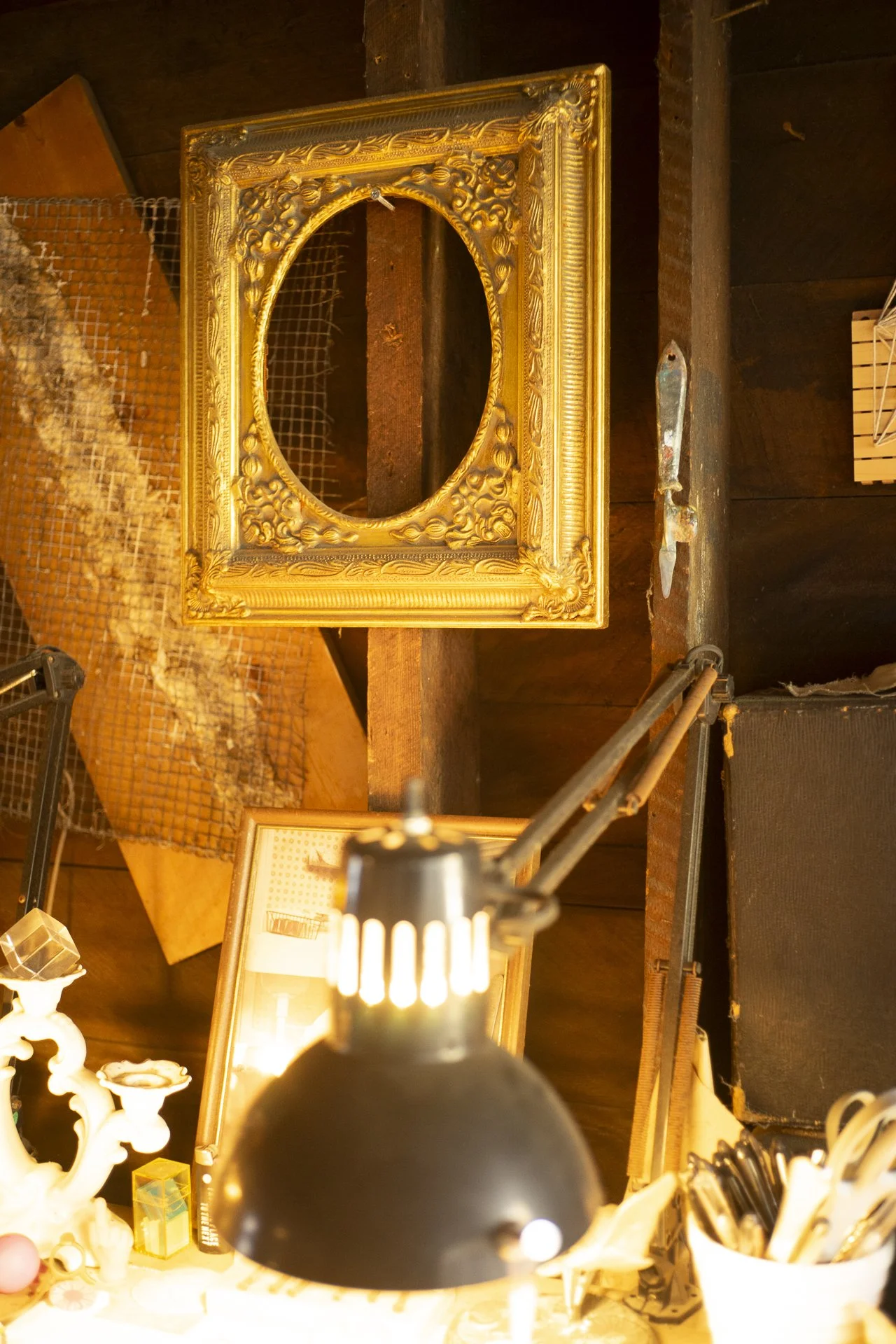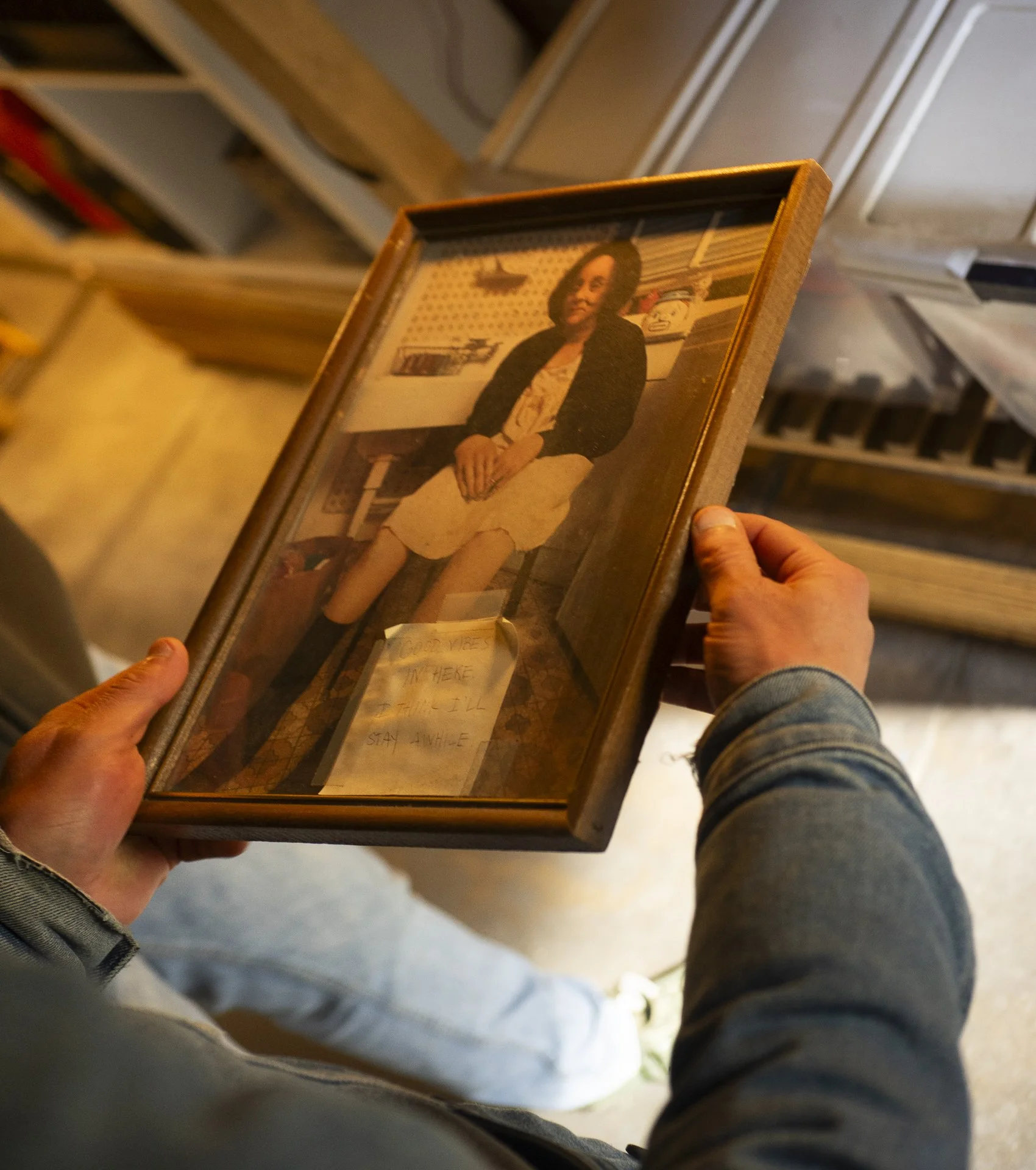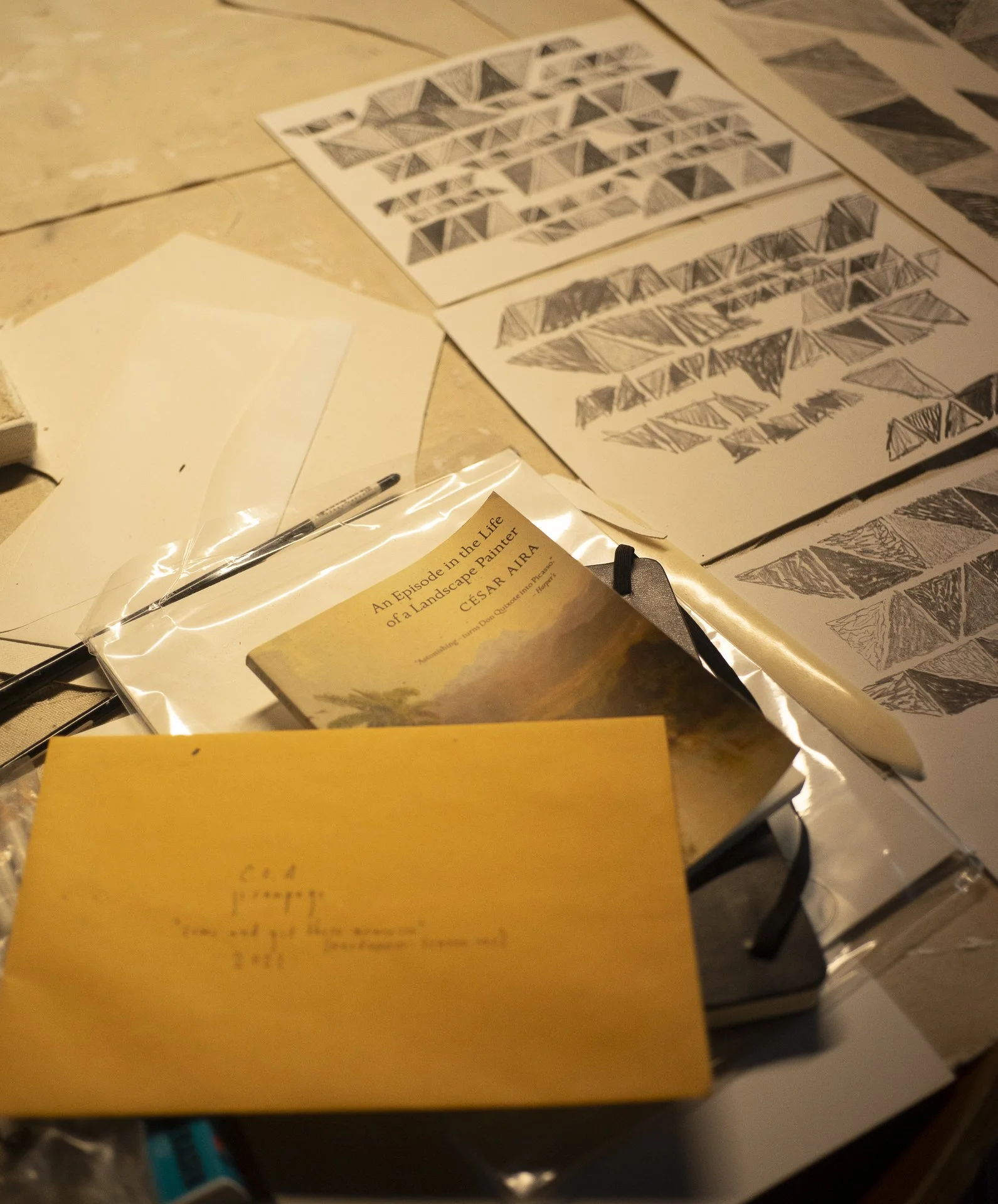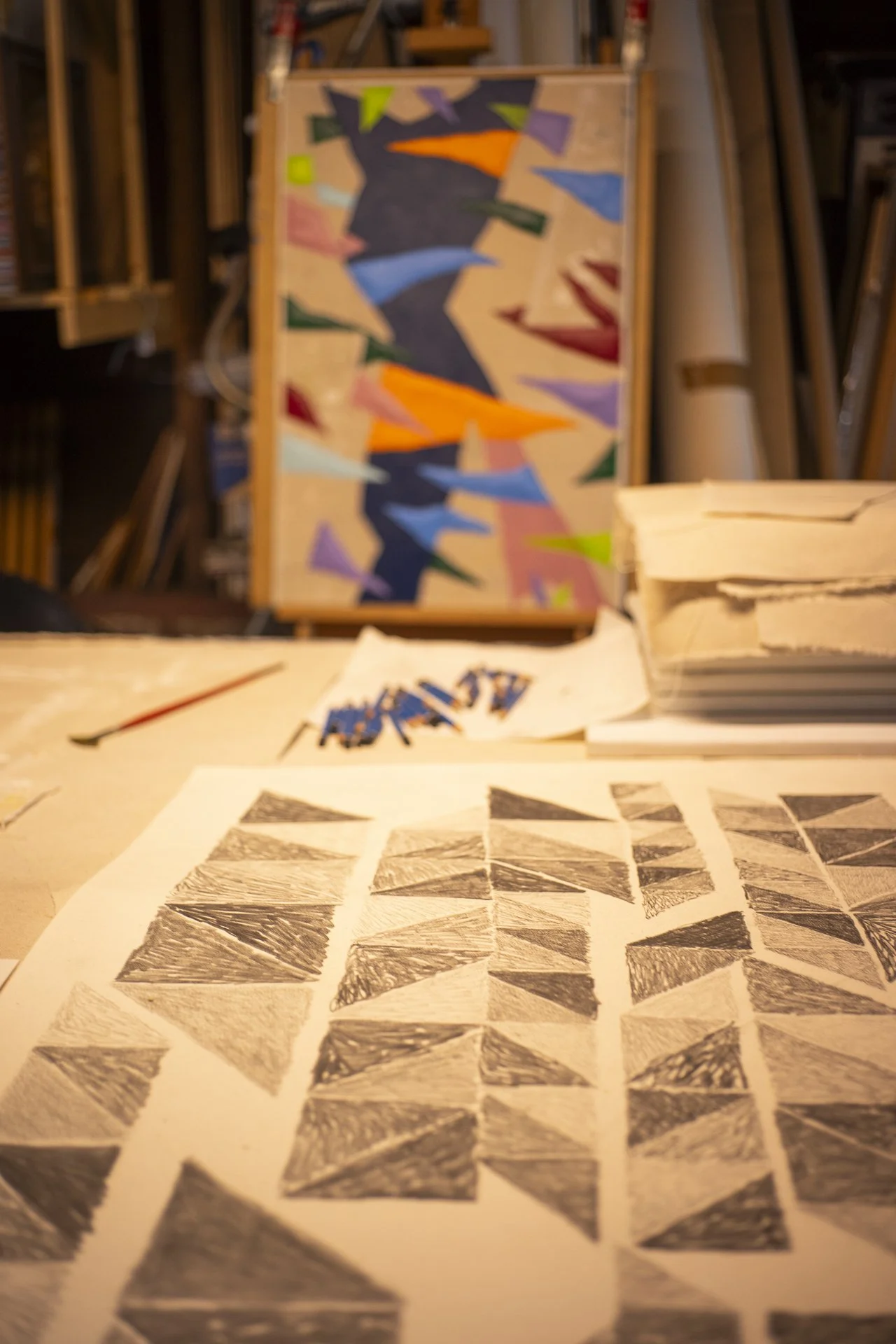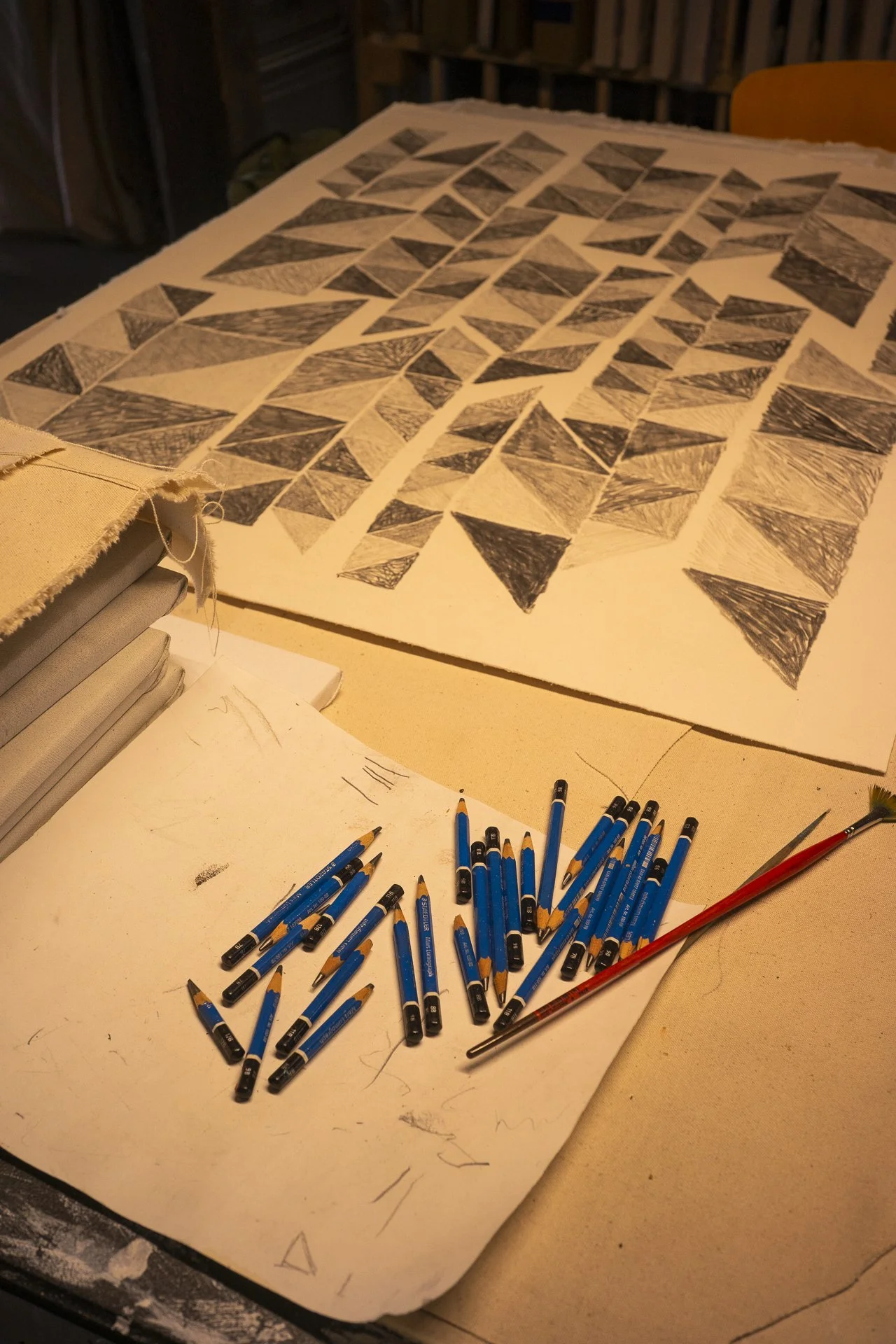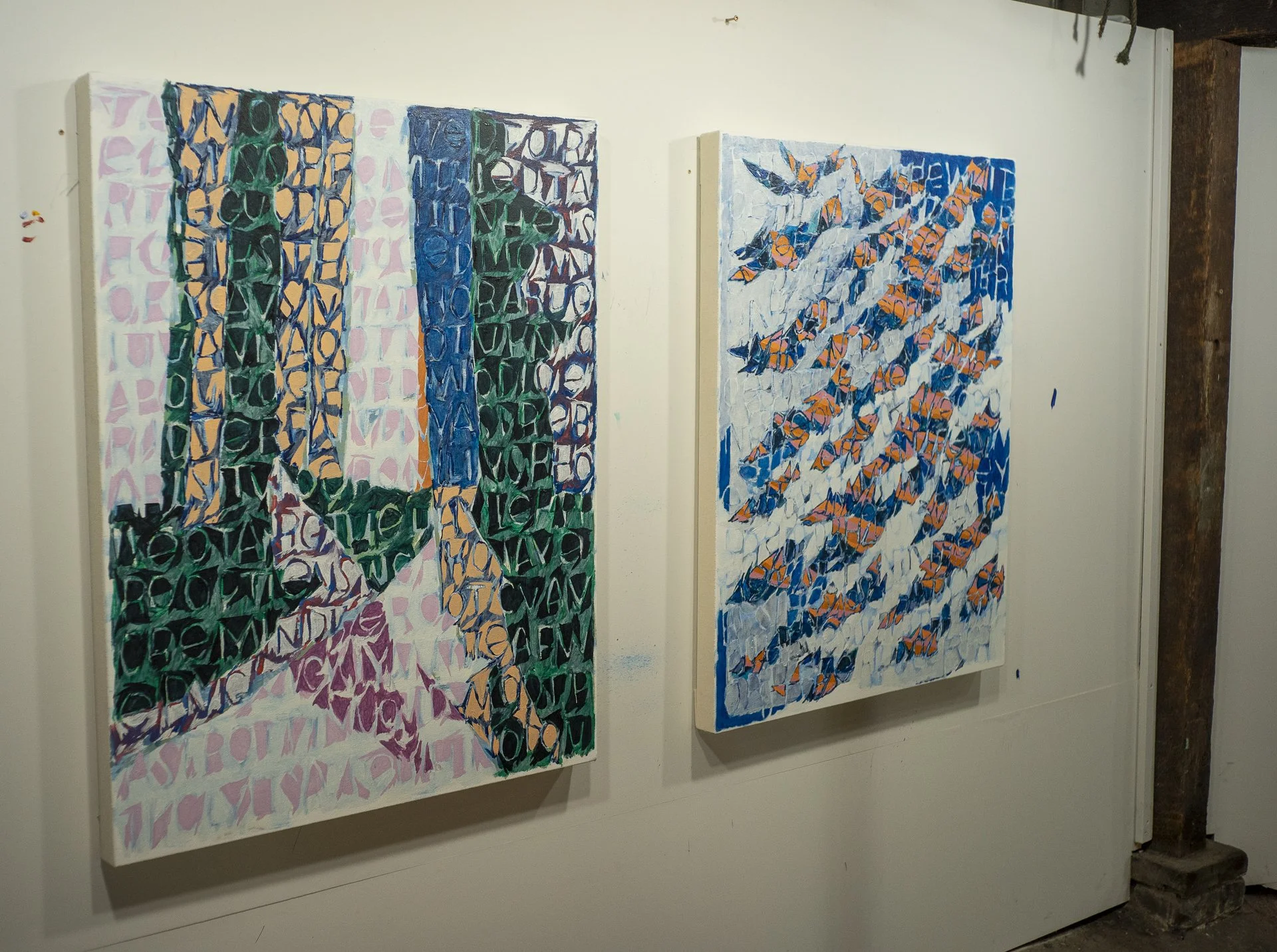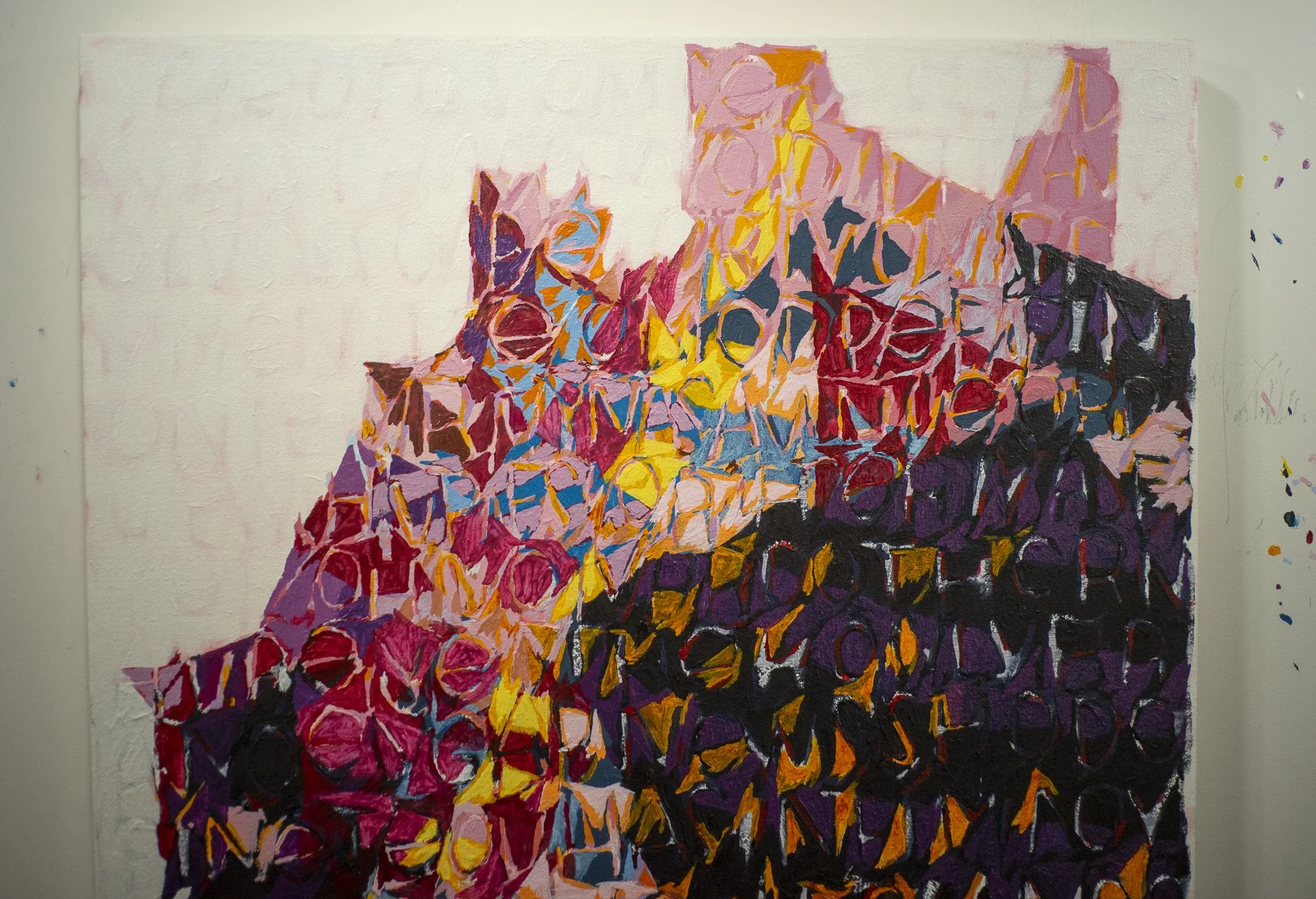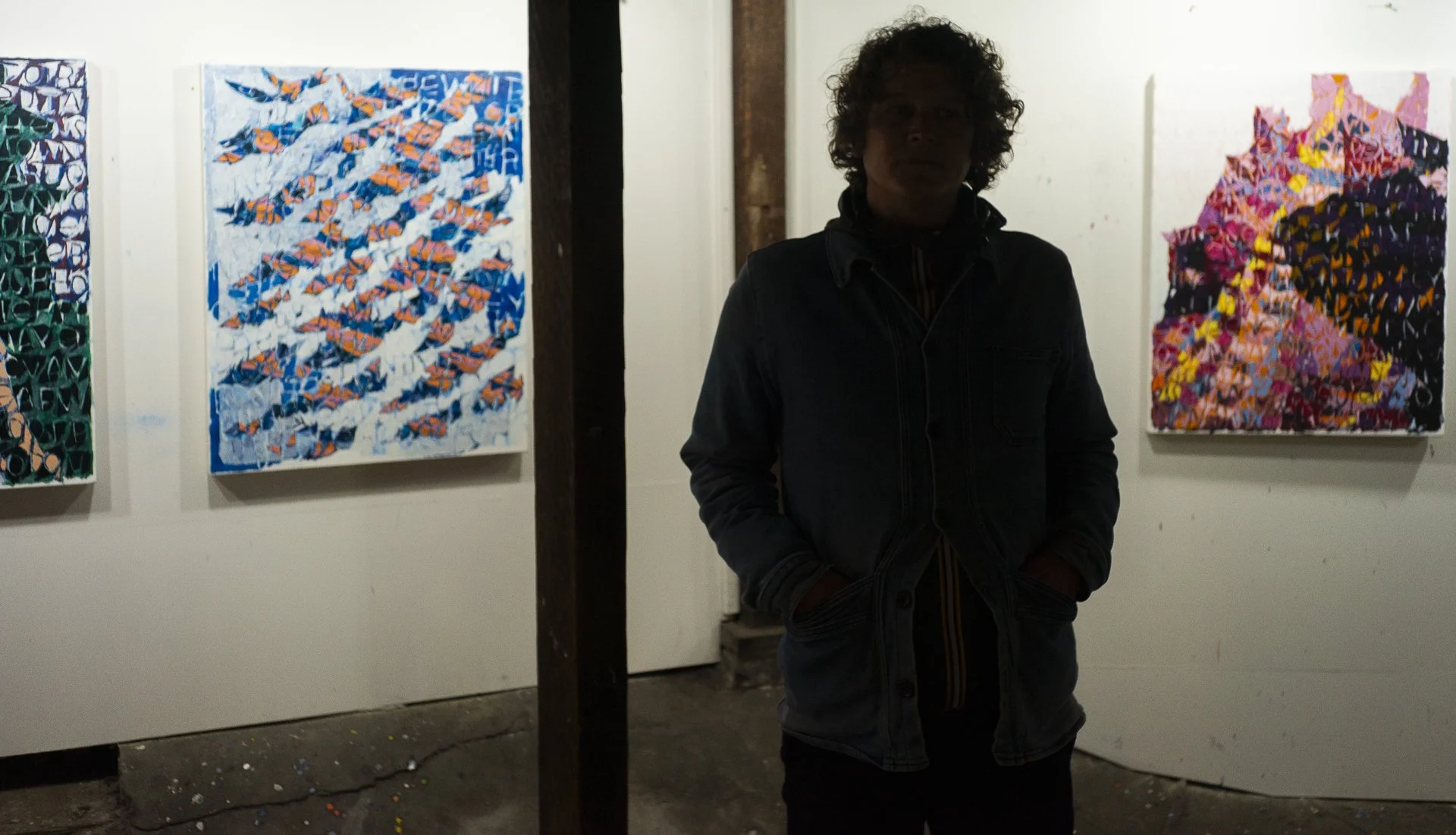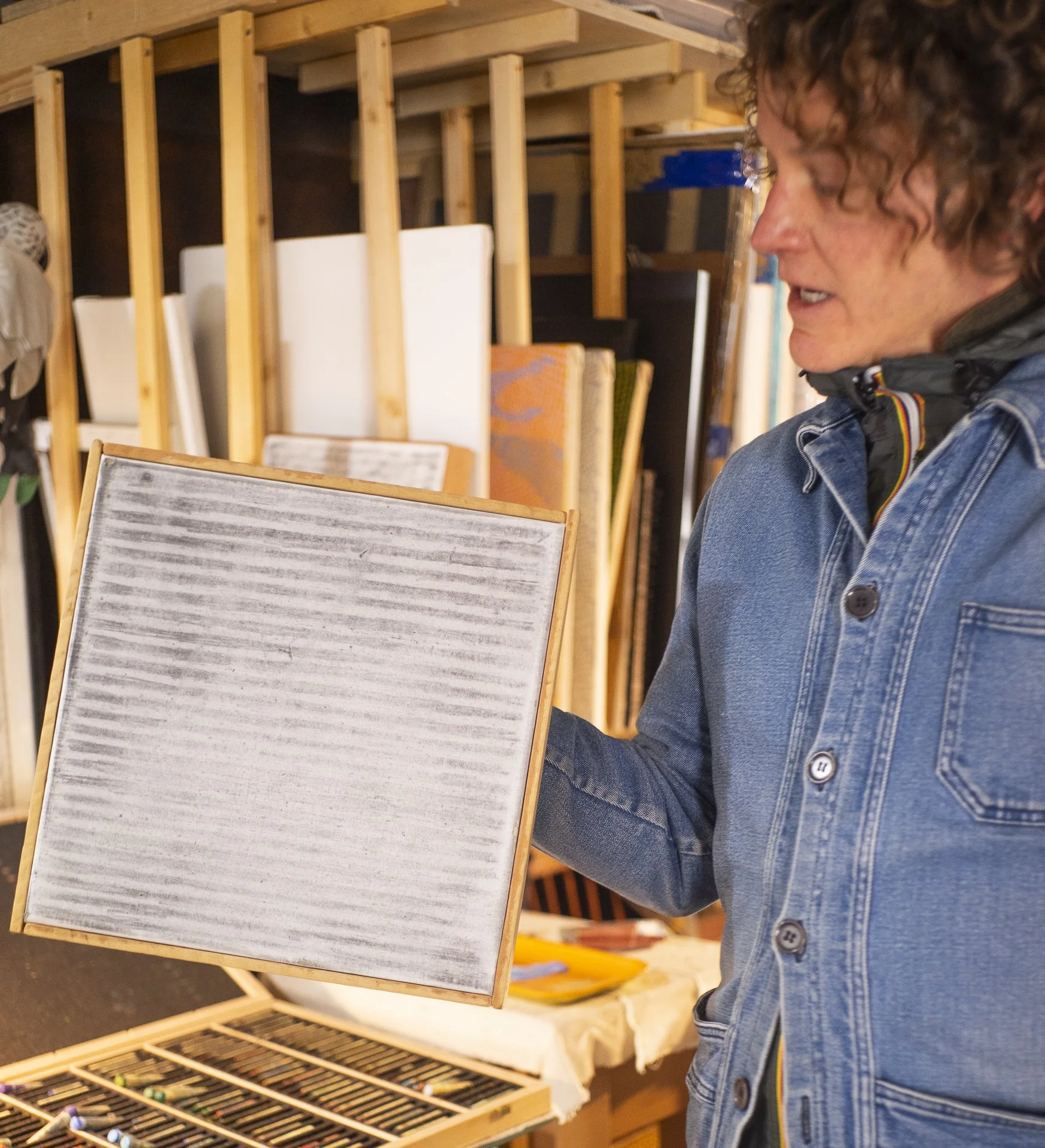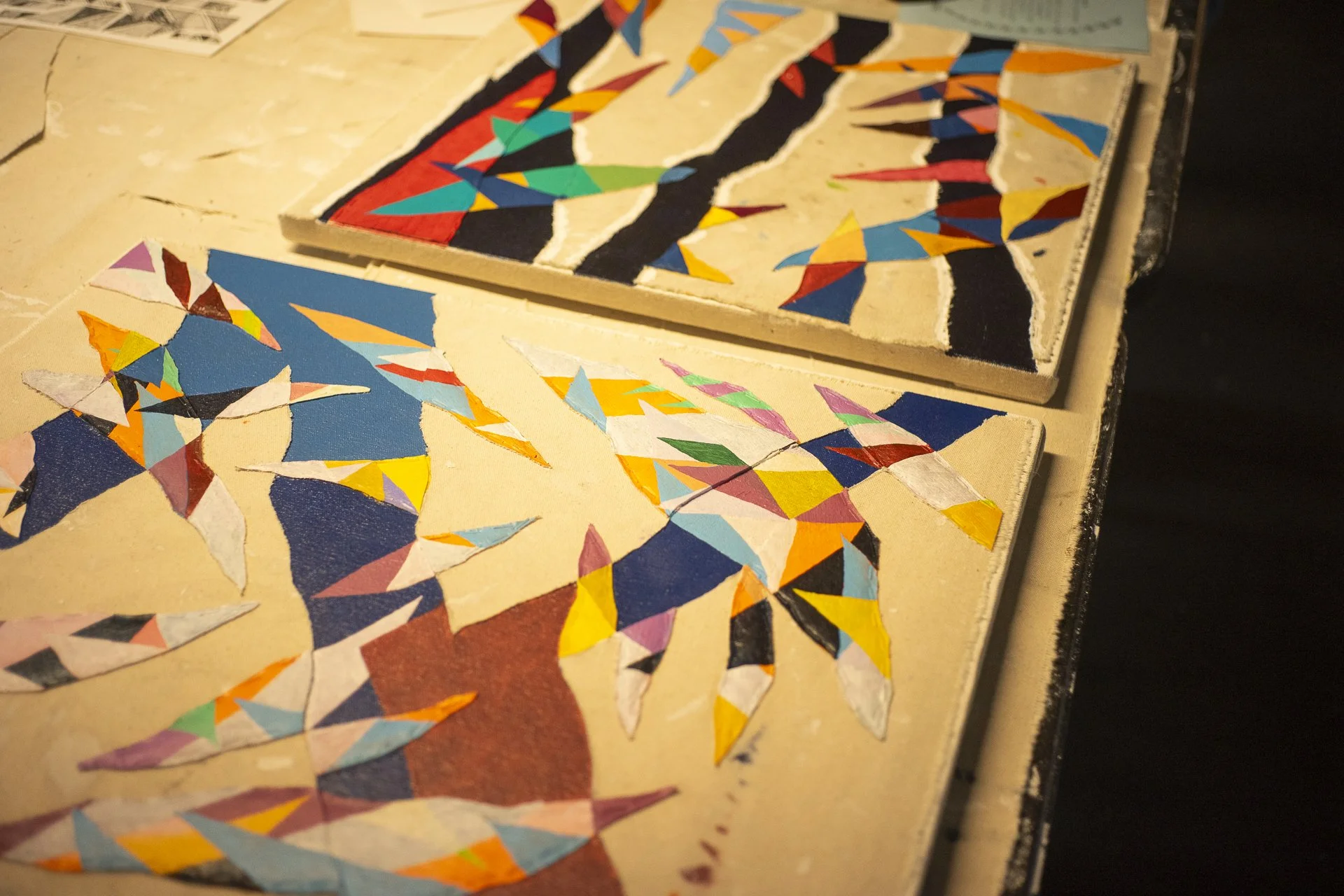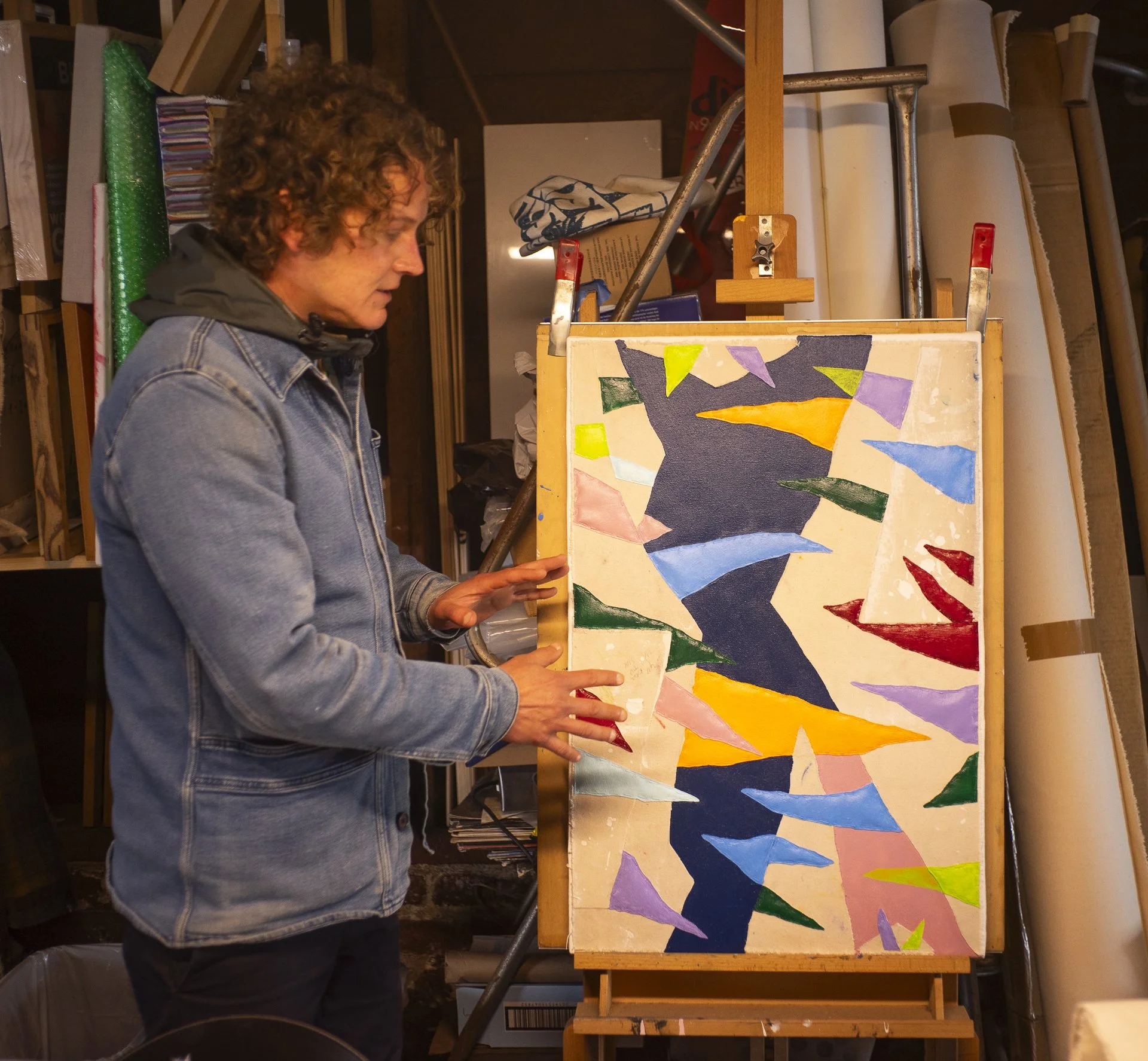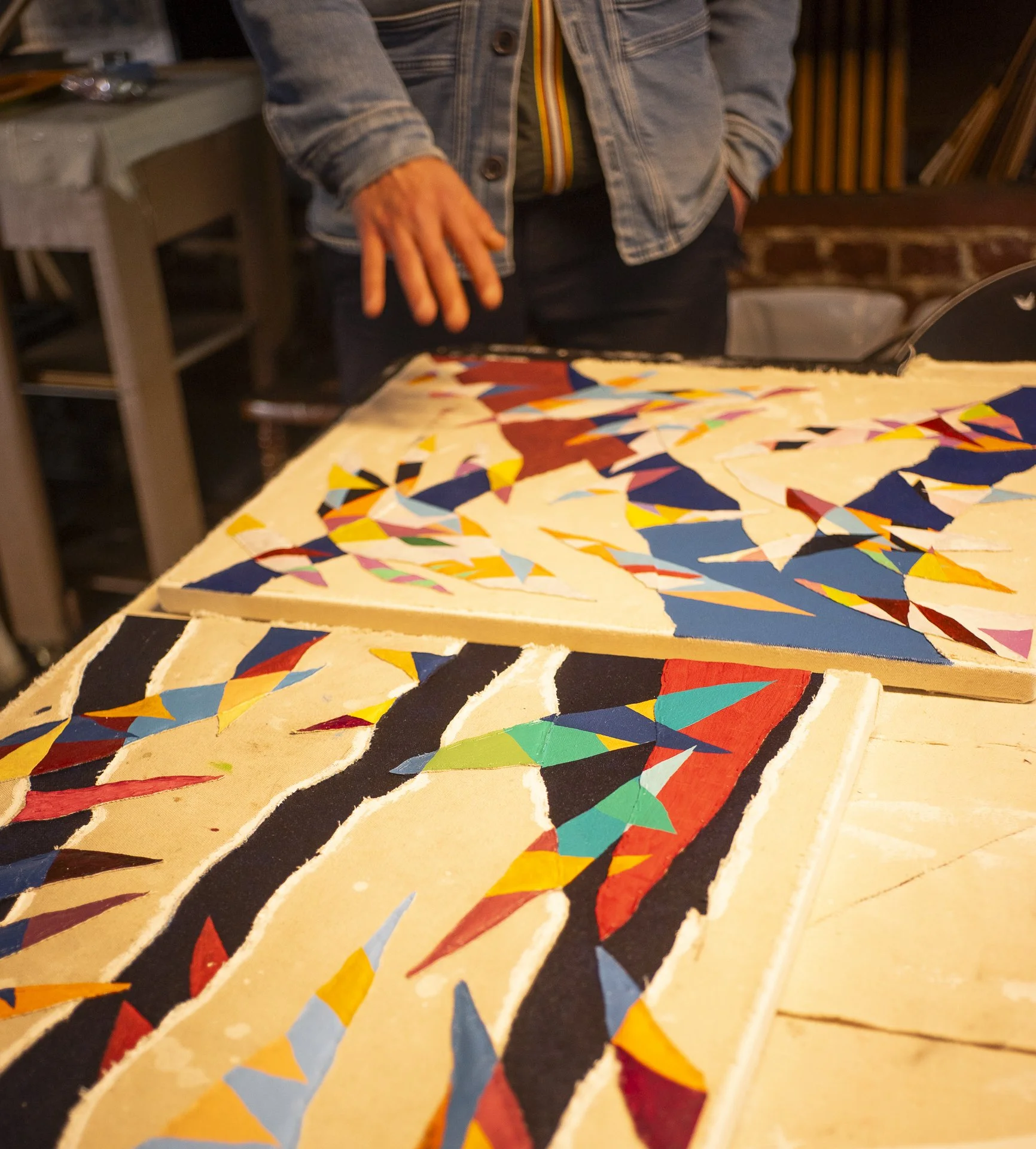Studio Visit & Interview With Joshua Rampage
Interview and Photographs by Brandon Joseph Baker
Joshua Rampage with a work in progress from his Secret Series.
On a crisp Spring afternoon I headed to the Mission District for a studio visit and interview with San Francisco based abstract artist Joshua Rampage. Moth Belly Gallery co-founder and curator, John Vochatzer, met me at Josh’s studio for coffee and conversations. We’ve been trying to get a studio visit together for well over a year but our combined work schedules thwarted our opportunities to meet. I find Josh’s diligence, focus and dedication to his work inspiring.
‘It’s an absolute privilege to work on my art every day. I wake up, do exercises, eat, shower and take care of administrative duties. Once I’m in the studio, I focus on the physical work only. I typically work four-to-five hours and then have lunch. Then it’s another four plus hours,’ Josh says of his daily routine.
The studio is beneath a Victorian and we enter through a roll up garage door. This garage lacks the scent of fuel or tire rubber. Instead oil paint and a hint of an extinguished rolled cigarette permeate the olfactory nerve. The subterranean space is clean, everything feels organized and ready to be used. I notice the lack of paint on the floor compared to the abundance of paints Josh houses in the studio. It’s telling of the care he takes in his process. Works in progress are hung on a large well lit wall, easels around the studio or on tables. The abundant bric-a-brac on the fringes of the workspace are uniformly arranged and beg to share their origin story. The vertical racks Josh adroitly constructed house the canvases he’s hand stretched, prepared, finished and signed. They stand poised in lined formation, ready to be shown or sold.
Josh’s Secrets Series is one of my favorite ongoing bodies of artwork from the artists I’ve met in The Bay Area. The bold choices of contrasting color collide with subtle muted undertones. Hues and brush strokes blend and morph around the hints of text which contain the secrets others have shared with him. ‘The Secrets Series is very conceptually-forward, but I like to think you don’t have to know the concept to appreciate them based on their aesthetic presence alone. I believe every single piece of art that has ever been made has secrets in them,’ Josh says about the series he’s been continuously working on since 2007.
Interview
Thank you for taking the time to meet with us and showing your studio. Let’s get started with your life and education in Chicago before living in San Francisco. What was life like for you in Chicago?
Chicago has a specific energy that is wildly different from the coasts. Summer never lasts long enough, and winter is cold as fuck and seems like forever. People have a traditional sensibility and mindset. I learned so much from that upbringing, but also knew it wasn’t exactly for me.
Growing up, I never had a dream to move to California; but then I did just that. I was playing with a band in Chicago and we felt like our sound was more aligned with what was coming out of San Francisco and the Bay Area. We visited once, were like oh hell yeah, this must be the place. And then made the official move to San Francisco in 2005.
You studied art at Indiana University Bloomington, what was your experience like studying art at a state school?
Very traditional, rigorous and exciting. I wanted to immerse myself in a diverse curriculum that encouraged more than just producing art. I wasn’t allowed to make work like I do now: every art class taught us about learning the rules before you can break them. Still life, color theory, live models; it was a very fundamental education. I had a minor in Sociology, and still believe that plays into my work more than anything else.
I’ve been to several shows you’ve curated and installed, how does curation of other artists' work inform your practice as an artist?
I love to be on the watch for what everyone is making. To have the honor to curate other artists and put them in a show is a challenge and a thrill. Being in a position to offer opportunities to other artists is an unmistakable feeling. I’ve been offered opportunities from other artists in the past, and this is a way that makes it feel reciprocal.
Artists supporting other Artists is a very special thing, especially when it can sometimes feel like everyone is competing, or not readily offering support. It means so much to me.
You have a deep knowledge of art history, which artists or movements have left the largest impact on you as an artist?
Do you remember the Daft Punk track “Teachers”? They basically just name-drop all the artists that influenced them into making that first record. So here’s my version: MARCEL DUCHAMP. Andre Breton and the Surrealists. Paris. Buster Keaton. Egon Schiele, Lee Krasner, Lee Bontecou, Christian Marclay, Jasper Johns, All the Artists who use text, Glen Ligon, Matt Connors, Jenna Gribbon, Mark Bradford, Joyce Pensanto, Australia, Maryam Khosrovani, my mentors Jason Aumann, Aldo Buffone, Erik Otto and Carmel Byrne.
Every single artist I’ve ever met, whether they are a jerk, or now a best friend, and everything in between has influenced me greatly.
Josh encourages visitors to his studio to sign and date the wall.
I’ve met many abstract artists here in The Bay who also spend a fair amount of time working as muralists. Have you ever done murals?
Not yet - but I’d love to. I have been assisting an artist in NYC (Erik Otto) for the past 5 years who has an extensive mural resume, and it’s been a swift and informative education in assisting to produce them. I believe my work would scale to something much bigger. I love painting large pieces on canvas, and it seems like the next logical step to transpose them onto a large wall.
What other forms of creativity do you lean into?
I love selecting records and dj’ing when someone asks me to. Being conversational. Being like a cartoon sometimes. Dancing Weird is creative. I like to do that. Sailing boats is less creative, but one of my favorite things to do. Romance is creative to me. There’s an art to throwing eyes.
How long do you usually work on a piece? Is there a moment when the piece is done and how do you know when that is?
My favorite paintings have evidence. It looks like the artist spent some real time with the work. So I kind of love/hate that most of my paintings take a long ass time to make, typically fifty hours-ish depending on how much pacing and considering vs. mark-making I’m doing.
I build, stretch and prepare all my surfaces, which means being twelve hours into the piece without making a single mark or color. Through this pre-process, it creates a situation where I’m forced to consider what I’ll produce.
I learned to tell myself “you will make the best possible work based on your preconditioning up to this point”. In a way, this takes the pressure off trying to make a masterpiece, and just focusing on making the best work I possibly can in that moment. And sometimes that works. Sometimes it doesn’t, but I roll the dice again.
I consider a work finished when it doesn’t need anything else. I fall in love with little sections as I’m working the piece, and once I’ve fallen for the whole thing, it’s complete. Insisting on adding anything more after that point has gotten me in trouble, so I skip that now.
You lived in Australia in 2012. What led you to live there and what was your experience like?
I played in a band for six years and it just stopped being fun. So I abdicated from the band and also the two-year relationship I was in. I still loved San Francisco, but there were too many sad romantic bummer reminders all around me.
When people asked 'why are you moving to Australia’ I told them- ‘to find some new dirt’. I had always wanted to live in a different country, and Australia makes it very easy to do. I lived in Sydney and Melbourne, had an Artist in Residence while living in Sydney and exhibited a handful of times in both cities.
We talked about how we both left our steady corporate gigs to pursue a life in art. You phrased the process poignantly, you are prepared and even embrace having your heart broken again and again as an artist. Can you tell me a little more about how you view the risk and reward of life as an artist instead of the stability of a 9 - 5 work life?
The traditional values of the Midwest say “there’s no fucking way you’ll make Art a career, you can’t make money doing it”. And part of me believed that enough to have a paycheck job for nineteen years before going full-time as an artist.
One big difference is you don’t get paid every two weeks. It’s like a rollercoaster, and I’m not the biggest fan of rollercoasters. The sacrifices and disappointments inherent in being a full-time artist are almost limitless. But the rewards are also limitless, even if they are far and few between.
I may not be rich in money, but I feel rich in so many other ways that make me realize I’m one of the luckiest people on the planet.
By being prepared to have your heart broken as an artist, you’re also preparing yourself to feel that real love when it comes along again. To me, anyone who hasn’t had their heart smashed to pieces never made a piece of work that felt like anything.
The intricacies and nuance of heartbreak teach us what it is to truly feel and love, and then persevere and make something from it, and roll the dice again and again until you can’t see the numbers on them anymore.
I find it interesting you worked as a graphic designer and are now an abstract painter. The two realms feel contrarian, what brought you to work in abstraction as style?
Graphic Design never really appealed to me as a medium or practice, even though it was my concentration in school. I really love typography and information designed to be communicated through aesthetics. I’m implementing the fundamentals and principles of Graphic Design (shape, color, form, balance, contrast and composition) into my painting practice, and in that way they don’t seem all that contrarian. Those are the very elements that make a painting to me.
I was never compelled to make figurative work after school. Sometimes I still draw fish, or something somewhat representational, but I’m very taken with the idea that abstraction comes from a place within; it’s like magic.
Abstraction can be transcendent and lovely when there is no readily available reference. Attempting to make something original and unfamiliar and have that translate to something beautiful and intimate to the viewer is a forever challenge to me.
I’m most familiar with your Secrets Series and really enjoy the complicated composition of colors and brush strokes that mask the secret written on the canvas. How did you get started on it?
The paintings I was making after school were very text-heavy and influenced by Jean-Michel Basquiat. After moving to SF, I met another painter who was also making text-based work. We would talk about the finite nature of having something legibly written into the painting, and how that was, in a way, limiting.
I was in the studio one day and I cut the paint too thin and after I applied the paint, it kind of redacted the text that was already there. For some reason, the first thing I thought of was “no one has made a series of paintings about secrets”. That was 2007. I’ve been courting this series since then, learning how to create a shape and color language that would complement but also abstract the secret someone had told me. By allowing the series to evolve, it’s been teaching me to evolve along with it.
Have you ever submitted an open call to submit secrets for your Secrets paintings? How do these secrets from others find you?
One time I sent out an email explaining the Secrets Series and asking if anyone wanted to submit. I had never asked for the secrets before, they just came naturally from my interactions with other people. I didn’t think anyone would reply. But they did - and I made four 4 x 4 ft. paintings from the secrets people told me and titled those paintings with their first names.
I think the way secrets find their way to me is that I tell people most of my secrets. I have a serious distaste for surface level aka boring ass conversations. Let’s get to the heart of things! And by this practice of intimacy and sharing, other people sometimes also feel inclined to share. I could not make these Secrets paintings without my interactions with other people.
Do you ever hide your secrets in your art or just the secrets of other people?
It occurred to me in 2020 to put myself in the hot seat - to see what it feels like to put something so sensitive and intimate like a secret onto the surface and make that the subject matter - and through that experiment came a new series I call my “Nocturnes”.
Instead of oil paint, they are graphite on prepared linen or canvas - the lack of color and shape language is what separates them from the Secrets Series. I write my secrets down like a diary entry, and then I take a power sander to the surface. I then rewrite and re-sand and do that about thirty-six times to reach the desired effect.
I believe every single piece of art that has ever been made has secrets in them.
Can you tell the readers a little about the Lonesome Doves series and how it’s different from your Secrets series?
It was 2023 and I had just returned from one of my self-imposed Artist in Residencies in NYC and was very fiscally challenged and told myself I should use the whole buffalo. I had leftover scraps of canvas and some panels and had wanted to make something more experimental and sculptural. When I first started making them, it felt like I should be up north in a cabin in the woods, snowed in with a fire going, it all felt very craft-y.
I was also thinking about how affectionate I am for Folk Art/Art Brut/etc; I almost always prefer naive work vs academically trained work. It’s weird and frustrating, because I am a trained artist.
In pursuing this new series, it felt like I was trying to forget everything I had learned, even though that’s impossible. There is something distinctly simple about the Lonesome Doves, but given a glimmer of pause, there is much more to consider.
I love things that appear simple, but are actually really complex.
What’s next for you?
Staying the course. That’s something I keep telling myself, and everyone, for that matter. I plan to keep believing in myself and my work, blindly and unconditionally, because no one else is going to do that for you. In fact, they might be doing that for you, but they’re just not telling you. Because they want to see you try so fucking hard, fail and fail, have moments of “success”, then more failure, sadness, heartbreak, frustration, wanting to give up so bad. But then not giving up. Not giving in. I think people like to witness the underdog have its moment in time. Staying the course and persevering and leaving a genuine mark on the world that you’re so lucky to live in and be a part of. We as artists are the luckiest ones.
I agree, I feel lucky to have had a chance to finally visit your studio and dig deeper into your work and process. Thank you.
